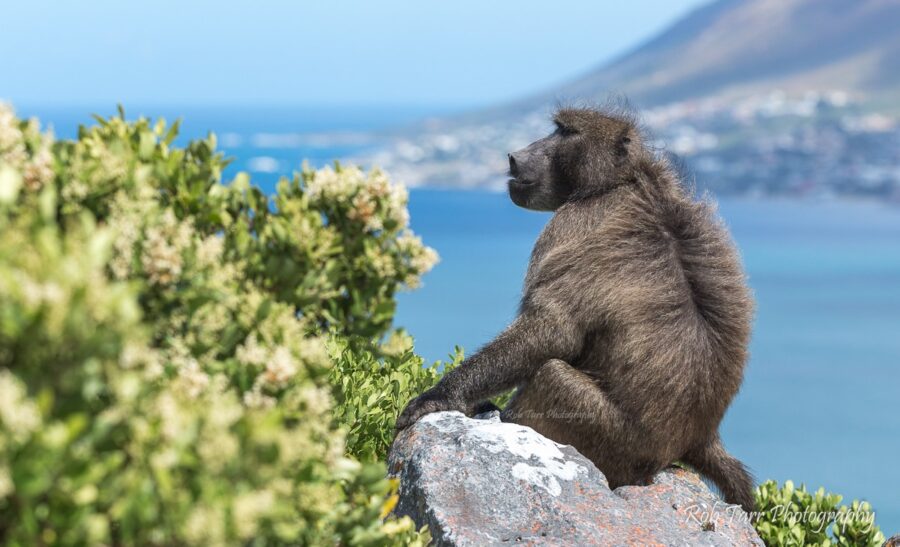
Baboons Belong… Just Not In Town
This article is a response to ‘Baboons Belong Campaign‘ published by SAPeople on 20/06/21 The City of Cape Town’s baboon program has been widely criticised for allegedly using inhumane and ineffective methods to deter baboons from urban areas and keep them within the protected area of Table Mountain National Park… write Esme Beamish and Justin […]

This article is a response to ‘Baboons Belong Campaign‘ published by SAPeople on 20/06/21
The City of Cape Town’s baboon program has been widely criticised for allegedly using inhumane and ineffective methods to deter baboons from urban areas and keep them within the protected area of Table Mountain National Park… write Esme Beamish and Justin O’Riain.
Given the City invests a staggering R15 million per annum to operationalise this almost exclusively non-lethal program, such criticism could understandably lead those who control the Cities frayed purse strings and their political leaders to simply pull the plug on the program.
But first both the public and the politicians need the relevant facts on the success of the program and whether the methods are ineffective and inhumane as alleged so that they can together make an informed decision and test the veracity of the media claims made by their vocal detractors.
What however constitutes success? The stated goal of the Peninsula Baboon Program has changed little since 2000: a sustainable population with reduced negative interactions between humans and baboons. This it was hoped would not only improve baboon welfare and conservation status but reduce the risks to human health and safety and damage to property.
So, is the population sustainable? The Peninsula baboon population has increased from 365 baboons in 2000 to 580 in 2020. That is an increase of 59% despite the rising tide of humanity and ongoing loss of natural land. The population is clearly sustainable.
Baboon welfare is less easy to measure. Before the current program began in 2011, 53% of all baboon deaths were attributed to baboons being in urban areas and dying variously from guns, cars, dogs and poison. Such deaths are of great concern from a wildlife welfare perspective because they cause uncontrolled harm and much suffering.
This period was characterised by poor funding, poor management structures, poor education of the general public in matters baboon and a service provider without any professional wildlife or conservation qualifications.
The period 2009-2011 saw the appointment of the first professional service provider, improved funding and better management structures including an active and vocal public stakeholder group.
Research findings were shared with the public and education improved. Deaths linked to urban areas reduced by 13%.
However, it was only in the period 2012-2015 that the first substantial improvements in welfare were evident. The combination of baboon proof fences and aversive conditioning with paint ball markers kept baboons out of dangerous urban areas for much longer and with that deaths linked to residents dropped by 39%.
Independent data revealed that aversive conditioning kept baboons out of urban areas variously from >81% to >98% depending on the adjacent land use to TMNP (urban and rural respectively).
More time in natural areas equates to improved conservation status.
In summary the City of Cape Town, Cape Nature and SANParks are together presiding over a baboon program on the Cape Peninsula that has resulted in more baboons with better welfare spending more time in natural habitat. This despite more people and the in the midst of the 6th great extinction on earth.
It is thus safe to conclude that baboons clearly do belong on the Cape Peninsula and the only major threat they face are campaigns that falsely portray the authorities, who have achieved this success, as both draconian and cruel when in fact the opposite is true.
By Esme Beamish and Justin O’Riain
*Please see response from Baboons Belong below.
Esme Beamish has a Masters degree from UCT on how permanent injuries affect baboon behaviour. She is currently an independent baboon researcher who for the previous decade has recorded population changes including the causes of injuries and deaths to baboons and how the population is changing over time.
Justin O’Riain is a Professor in Biological Sciences and Director of the Institute for Communities and Wildlife in Africa and has supervised 5 Phds, 8 Masters students working on Peninsula baboons in addition to publishing more than 20 peer reviewed articles on the Peninsula baboons.
***
- Response from Lorraine Holloway, founder of Baboons of the South:
Baboons of the South advocates distance from baboons and keeping them out of town
There are no falsehoods about the Baboons Belong campaign. It was done in an effort to explain why they belong and EMPHASISE that they need to be kept out of town. Most certainly not in town. Our posts speak to that intention.
Every programme no matter how good it is considered to be by those who created it and manage it, all programmes need to be reviewed as circumstances change around us. That is a given.
In our opinion the protocols are draconian as the measures that need to be in place to prevent a baboon’s behaviour from escalating to a stage where the protocols are considered are not there at the level they should be. Something as basic as waste management is just not in place.
There are many strings to the bow of baboon management and these need to be understood.
In the urban context, baboon management has to be multi-faceted in terms of solutions to keep baboons in the natural spaces. It is not due to any one solution but many. Communities need to cooperate and comply; the City needs to provide communities with the tools that they need to comply (bins, and education); to ensure compliance there need to be bylaws and fines for non-compliance; the service provider needs a workable strategy and well trained and baboon orientated staff to manage our baboons; the Authorities need to work collaboratively and allow/encourage public participation in terms of their policies; and other contributors to facilitating baboon management such as the scientists and animal agencies need to play their part in creating solutions; and a strong community representation structure needs to be in place. And most importantly there needs to be a mangement plan for our baboons.
Further urbanisation requires a much higher profile when it comes to planning approvals within baboon ranges. Everything possible needs to be done in the planning stages to baboon proof. This is not rocket science either.
In our opinion all of the above is not functioning in tandem at this moment in time. Instead of arguing about the success of any programme can we not get around the table and discuss all the issues and take baboon management forward in a positive and inclusive manner.
Walking the same path of rhetoric again and again will not change anything.
For the record, Baboons of the South has always advocated for distance between baboons and humans, and keeping baboons out of town and we are strongly opposed to the killing of baboons when all measures are not in place to prevent this. There have been 75 male baboons killed from 2012 to date.
Our intentions have been very clearly stated over the years in a factual and professional manner, nothing less. Largely we have been ignored especially when it comes to the review of policy issues.
We respect the City for providing the budget for the management of baboons but why not open a dialogue with those outside the administration who have offered many suggestions and solutions. We all want the same thing: the best use of resources and a successful baboon programme. The reluctance is beyond our understanding.
Coincidently I did have a conversation with one of the authors of this article this week and put the BOTS side on baboon management but maybe we need to converse again as we appear to be walking past each other on this matter.
BOTS focus is on being solution-driven to prevent baboons being in town to ensure their safety. Otherwise how can you impose these protocols?
Can we stop the train and find solutions. Baboons are not criminals. Human behaviour has painted us into this corner with baboon management.
